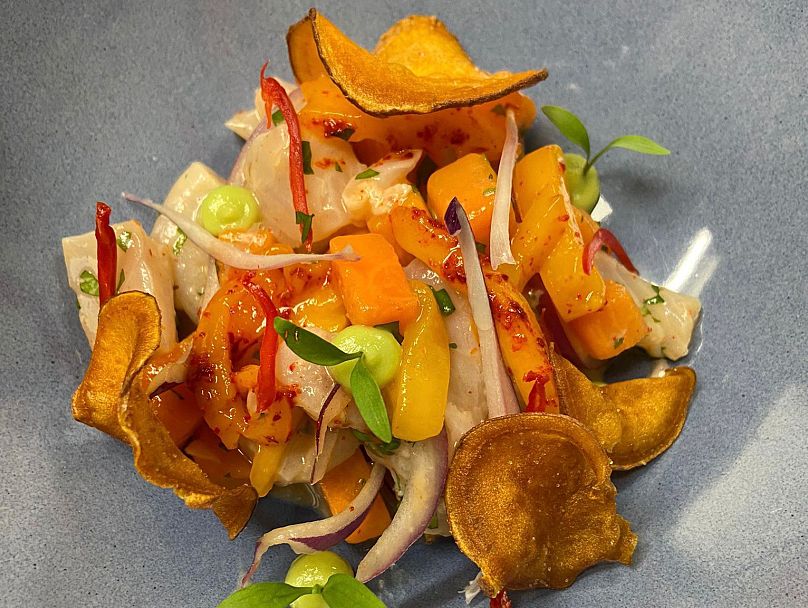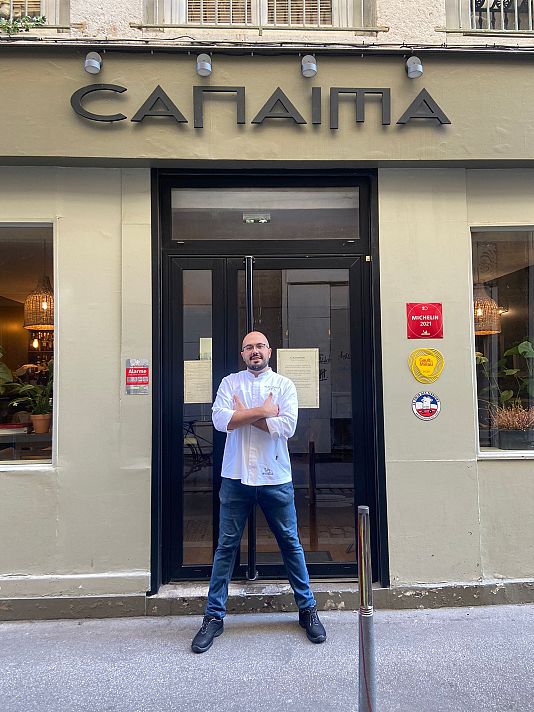Lyon based Venezuelan chef Chef Andrés Sandoval shares with The Kitchen his unique Ceviche recipe. The dish makes a tricolore of his traditional french culinary education at Paul Bocuse, his Caribbean upbringing and Latin spices fascination.
Chef Andrés Sandoval is owner and chef at Canaima, a French-Latin fusion restaurant in Lyon, France. Sandoval was born in Venezuela, but emigrated to France and graduated from the prestigious I_nstitut Paul Bocuse. He shares with The Kitchen his recipe for Ceviche, evoking the Caribbean for the end of the European summer._
Originating in Peru, ceviche is a popular and traditional South American dish that has become a trend worldwide. Some historians believe that the “cooking” technique used to make ceviche was created 2000 years ago by the Mochica culture.
Sea bream Ceviche with mango and espelette pepper
For this recipe, I chose Dorade, or sea bream, which is a white meat fish with a very delicate flavour. You can replace it with any white meat fish, the only must: it has to be fresh.
Serves: 4
Cooking time: 1 hour
Ingredients
- 1 kg of Sea Bream, Dorade Royale, or other white meat fish (you need the entire fish)
- 1 sweet mango
- Lime Juice from 8 green limes (lemons work too, but they tend to be bitter)
- 1 Red onion
- 1 Sweet potato
- Fresh coriander
- Espelette pepper
Method:
- Clean your fish, gut it, and take out the fillets. Take the skin and spine from the fillets and cut your fish into 1-2 cm cubes.
- With a spoon, scrape any meat that’s left on your fish and put it in a bowl (the rest of your fish is essential to make the leche de tigre (tiger's milk): the Peruvian-original citrus-based marinade used to cure (cook) the fish in a classic ceviche.
- Keep fish in the fridge while preparing the rest of the dish.
- If you prefer skipping this step, ask your local fish market to give you the fish already diced. You can use a part of it to do the “Leche de Tigre”.
- Chop the rest of the ingredients: Peel and cut your mango and onion into thin slices. Peel and cut your sweet potato into cubes of 1-2 cm and cook them for 5 min in boiling water with salt, then pass them through cold water to stop the heat from overcooking them inside. Chop your coriander and save the stalks.
- Moving on the leche de tigre. Take the bowl with the fish leftovers and add the cooked leftovers from your sweet potato, coriander stems, 1/4 of your onion or any leftovers and the lime juice. Mix this well and let it sit in your refrigerator for 30 min. Then take it out and pass all the mixture through a strainer. Squeeze everything delicately, you only want the liquid. (Doing this will help you add more flavour to your dish and balance the acidity of the green lime.)
- Now that all the ingredients are ready, you can marinate your fish cubes with the leche de tigre and salt for 10 minutes. The acidity of the lemons and salt, will “cook” your fish. Once the 10 minutes have passed, add the rest of your ingredients (coriander, sweet potato, mango, red onions and espelette pepper powder). And you're done!
- Extra tip: If you want to add an extra crunch to your ceviche try doing so with some sweet potato chips. You only have to slice your sweet potato into thin slices, and then fry them at 160 degrees. Drain the excess oil with paper towels, add some salt and enjoy.
Pair it with: A white sauvignon blanc could go very well with your ceviche. We love a fresh William Cole Mirador sauvignon blanc, from Casablanca, a famous wine region in Chile.
My history with ceviche
As a child, I used to go with my grandfather and grandmother to their apartment in “La Guaira” (the biggest port city in the country) to enjoy the sea breeze, the beach vibes, and the freshly caught sea delicacies.
We used to wake up early in the mornings to be at the fish market at the moment when fishermen arrived with their little boats filled with fresh catch. I learned a lot about fish with my grandparents and prepared many dishes with them, including my first ceviche.
Growing up in Venezuela, a Caribbean country with more than 4000 km of coast, having fresh fish was a usual commodity. And ceviche is a dish with which I grew up.
Fast forward to today, the art of making ceviche has expanded, evolved and new elements have been added to give the traditional dish a twist.
With time I improved my technique, and when I began my studies at Paul Bocuse’s Institut I perfected it and added personalised Caribbean touches. Today I share them with you.













